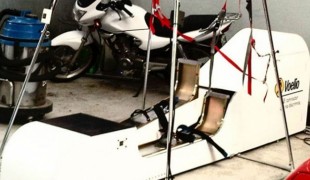- 12482
- 716
- 37
- 32
- 0
- Help Ukraine
About the solution
EpiSafe consists of a safety device designed to act as a monitor/alarm for epilepsy patients and their caregivers in order to prepare for a seizure event and to act as a recording/sensor device for collecting data for clinicians who manage the disorder in primary and secondary care.
“My brother Trevor passed away from a seizure and I suffer from a milder form of it myself, so I know how vulnerable it can be for someone with epilepsy”, the entrepreneur observed.
The device consists of hardware and software design to monitor the triggers of an epileptic seizure in a non-invasive way. It is connected via wireless to the user’s phone, and is worn on the wrist. The product gathers data related to the user’s blood oxygen level, heart pulse rate and movement to determine the factors that triggers a seizure. If the user has a seizure, the device will alert the caregivers.
“I had an engineering friend who was a great help in terms of the hardware side of the project”, Audrey explained.
Audrey also created this device because of her school – She was taking her Bachelor of Commerce in Marketing course, and undertook a Innovation, Creativity and Enterprise module where she was required to engage in group based projects with the aim to develop a unique enterprising idea.
The inventor is now seeking funding from investors in order to advance to the next stage of production, including developing a prototype and carrying out clinical trials.
“Anything that can help someone lead a more normal and independent life is definitely worth the work put in”, she expressed.
More info: http://episafeireland.wix.com/episafe
Adapted from: http://bit.ly/1X4myu1
What about you, do you have any solutions? Please share them with the Patient Innovation community!
This solution shall not include mention to the use of drugs, chemicals or biologicals (including food); invasive devices; offensive, commercial or inherently dangerous content. This solution was not medically validated. Proceed with caution! If you have any doubts, please consult with a health professional.
DISCLAIMER: This story was written by someone who is not the author of the solution, therefore please be advised that, although it was written with the utmost respect for the innovation and the innovator, there can be some incorrect statements. If you find any errors please contact the patient Innovation team via info@patient-innovation.com
-
-
290
-
0
-
3380

Teacher Alex Truesdell is Transforming Lives: Adaptive Design Association Revolutionizes Disability Solutions
CAREGIVING
Drawing
Painting
Playing
BODY BALANCE: Maintaining body balance
(SELF)-CARE: DRINKING: Drinking independently.
(SELF)-CARE: EATING: Eating independently.
MOVING IN A WHEELCHAIR: Moving using a wheelchair.
Playing an instrument
Studying
Blindness
Hand Deformity
Neuromuscular Disorders
Assistive Daily Life Device (to help ADL)
Walking Aid (wheelchair/walker/crutches)
Restoring mobility
Replacing lost limbs
Enhancing health literacy
Promoting self-management
Promoting inclusivity and social integration
To improve Treatment/Therapy
Preventing (Vaccination, Protection, Falls, Research/Mapping)
Raise awareness
Caregiving Support
General and Family Medicine
Internal Medicine
Orthopedics
Pediatrics
Physical Medicine and Rehabilitation
United States
-
-
-
345
-
0
-
4243

Collaborator Pierluigi Mantovani creates Evolution Devices - solutions that aim to transform Multiple Sclerosis Management
CAREGIVING
BODY BALANCE: Maintaining body balance
STANDING UP: Standing up from a seated position
WALKING: Walking
Multiple Sclerosis
Assistive Daily Life Device (to help ADL)
Walking Aid (wheelchair/walker/crutches)
App (Including when connected with wearable)
AI algorithm
Body-Worn solutions (Clothing, accessories, shoes, sensors...)
Restoring mobility
Regaining sensory function
Managing pain
Promoting self-management
Preserving Organ Function
Managing Neurological Disorders
Maintaining Balance and Mobility
To improve Treatment/Therapy
Preventing (Vaccination, Protection, Falls, Research/Mapping)
Raise awareness
Caregiving Support
General and Family Medicine
Internal Medicine
Medical Genetics
Neurology
Physical Medicine and Rehabilitation
United States
-
-
-
510
-
0
-
9058

Father creates walking aid for his son
WALKING: Walking
WALKING WITH A WALKING AID: Walking with a walking aid
CAREGIVING
Cervical spinal cord injury/Tetraplegia
Walking Aid (wheelchair/walker/crutches)
Restoring mobility
Promoting self-management
Preserving Organ Function
Rehabilitating After Stroke
Managing Neurological Disorders
Recovering from Traumatic Injuries
Maintaining Balance and Mobility
To improve Treatment/Therapy
Raise awareness
Caregiving Support
General and Family Medicine
Internal Medicine
Neurology
Pediatrics
Physical Medicine and Rehabilitation
Argentina
-
 en
en